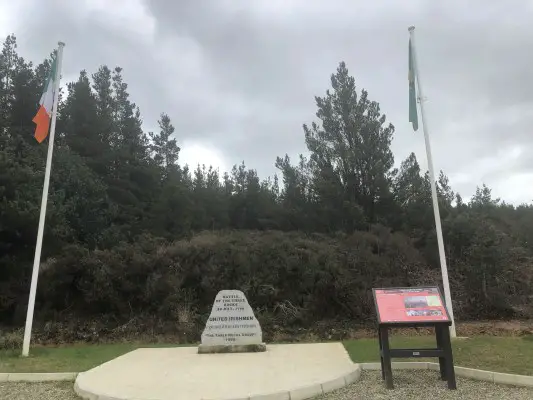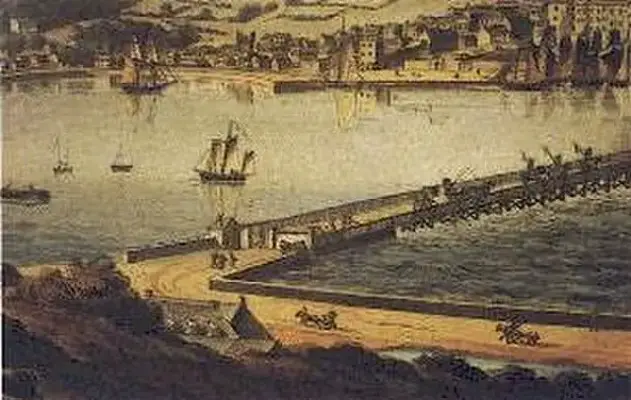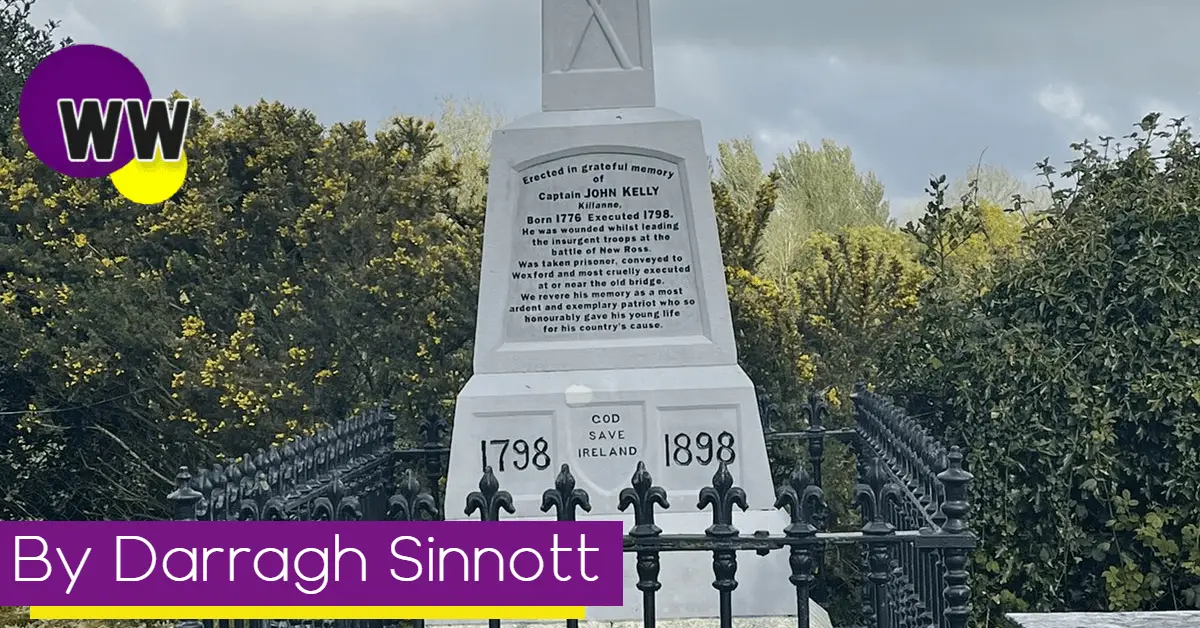In Wexford, we are rather proud of our rebellious past…
In every small town and village throughout the county, there are many striking monuments to the gallant deeds of the men and women of the 1798 rebellion. Indeed, as a people, we feel a swell of pride when the major events of the rebellion are recounted.
As the centre of the United Irishmen’s rising, we have just cause to admire the near mythical heroes of the conflict. Although we are now separated by more than two centuries from the swift defeat of British forces at the Battle of the Three Rocks or from the valiant last stand of rebel forces at Vinegar Hill, one can’t help but feel tethered to the courageous actions of those who came before us.
We are reminded of these events in many ways through the epic stories passed down from generation to generation, the aforementioned monuments, the old battle sites, and various other reminders to be seen throughout the county.
However, one of the most enjoyable and widely appreciated method of commemoration of the bravery of ’98 was through song. One song has risen to wide national acclaim and popularity; it was a song written by balladist Patrick Joseph McCall detailing the involvement of a valiant, inspirational rebel, John Kelly, the Boy from Killane.
This ballad with its powerful tune and rousing lyrics, it is to be heard in many a pub or musical session throughout the county. The song is no doubt beloved and a point of great pride, however, very few know the story of “Dauntless Kelly”.
So, who exactly was Kelly the Boy from Killane?
In 1776, John Kelly was born to Mary Kelly (neé Redmond) and John Kelly senior. There is a flawed stereotypical idea of the Irish rebel being as being typically Catholic, and perhaps come the later of War of Independence, this idea would be more truthful. No doubt, the majority of the soldiery were Catholic, however the national movement of the United Irishmen was not a sectarian one.
As their Protestant founder and leading figure Theobald Wolfe Tone stated, they aimed “to substitute the common name Irishman in place of the denominations Protestant, Catholic and Dissenter”. And Wexford was no exception to this mantra.
Baegnal Harvey (A Protestant barrister and future President of the Wexford Republic) fought proudly alongside Fr. John Murphy (a Catholic).
John Kelly was himself born to a Protestant publican and tenant farmer. He was supposedly a churchwarden in St. Anne’s Church, Killane. Although Kelly’s Wexford heritage is undoubtable, the Kelly family had originated on the other side of the looming Mount Leinster in county Carlow.
Kelly lived a rather unremarkable, unspectacular life for his earlier years. One could imagine that he aided his father on the farm and in the public house. No doubt, he had become a familiar face to many within his locality, however there was no clear sign to signal that Kelly would have his name enshrined in the annals of history.
The Society of United Irishmen was founded in Belfast in 1791 by fervent republicans such as Wolfe Tone and Robert Emmet. Kelly was but fifteen years of age when the society was founded, but despite this, he was rather keen to join. So keen was his interest that his mother had to strongly oppose his newfound desire and dissuade him from joining. Perhaps she was merely being cautious and protective due to the fact her family had received severe punishment for standing to the oppression of British rule.
The emergence of the United Irishmen clearly troubled the British administration, the fear of insurrection and uprising led to the banning of the United Irishmen and made membership a punishable crime. However her young, rebellious son seemed to pay little heed to her, although her strong warning and the crack down on the Society may have delayed her son’s involvement.
A letter written by John Kelly to a Mr. Colclough of Duffry Hall in 1797 shows that it was evident the by the time Kelly had turned 21, he had an association of some sort with the United Irishmen. Despite the association, there was no signs that he had intimate knowledge of the society and was most likely not very deeply involved at this time.
John was not short of republican influences in his life; his cousin Fr. Mogue Kearns and his close friend Thomas Cloney, a future General in the 1798 Rising, no doubt helped to mould the desire for freedom within the young man. It is rumoured that the United Irishmen had been actively recruiting in North Wexford at the time with a member of the United Irishmen from the north of the country, namely William McCabe, heading the drive for recruits.
Dublin was initially intended to be the epicentre of the rising, but the United Irishmen were riddled with spies and informers including the brother of Wolfe Tone. The initial plans were scuppered, and so already the rebellion was limited in its national potential.
However, Wexford stood boldly and rose to the occasion. In the summer of 1798, John Kelly, who was aged just 22, enlisted in the rebel force and was appointed captain. On the 29th of May, Kelly marched his men to link up with troops throughout the county.
Captain Kelly lead his forces alongside those of dear friend, General Thomas Cloney. The two ambushed and routed British forces at the Battle of the Three Rocks with an impressive 10,000 men under their command. Word of the glorious victory won by Forth Mountain spread and the rebel forces swelled to 20,000 men.

The 1,200 government soldiers stationed in Wexford realised the numerical disadvantage they now found themselves at, fearing a massacre they abandoned their post. Due to the actions of Kelly, Cloney and their men Wexford had fallen with little struggle.
Baegnal Harvey assumed the position of the newly proclaimed Wexford Republic. Harvey now controlled not only the town, but most of the county. Wexford was under the firm control of the United Irishmen. Kelly was considered a pivotal piece of this military machine and must have been widely revered as Harvey called upon him to lead an attack on the British outposts surrounding New Ross.
Kelly efficiently disbanded the British presence around New Ross; the rebels now gathered their force of around 10,000 men on Carrigbyrne Hill to face down the 1,200 British troops garrisoned in New Ross. The plan was to take the town and then to cross the Barrow and spread the rebellion to Kilkenny. Today, the rivalry between Kilkenny and Wexford may not be confined totally to the Leinster Senior Hurling Championship, it may perhaps be rooted in the Battle of New Ross. It is alleged that a group from Kilkenny crossed the Barrow and urinated in rebel gun powder rendering much of it useless in battle. This was in an attempt to stave off the rebel forces and if true, it would have proved quite consequential in the forthcoming battle.
Harvey wished to see a swift end to the battle and had no intention of massacring the British troops. He sent Matthew Furlong bearing the white flag of truce in order to offer the British the chance to surrender. However, in a manner most callous, dishonourable and malicious, the unarmed Furlong was shot dead by the British troops as he approached under the white flag.
Enraged, a group of around 500 men lead by the furious John Kelly rushed to route the insolent British forces and in their initial charge at the Three Bullet Gate, they made great advances. They had captured two thirds of the town and they had the British garrison on the back foot. At the moment when victory seen certain, the rebels ran out of ammunition.
The rebels had to resort to using pikes to continue their advance. The British, emboldened by this development, pushed the rebels back out of New Ross and it turned into a massacre. The numerically inferior British troops were ruthless.
Captain Kelly was wounded in the leg and he was brought to a safe house in Wexford town to recuperate. Kelly’s supposed Fiancé Molly Doyle fought valiantly in the battle urging on her comrades and using her scythe to slash to ammunition belts from the British soldiers in order to replenish the dwindling supply of rebel ammunition.
Molly was allegedly cut down in the fighting and her 22 year old husband would not face much brighter a future. The Battle of New Ross left chaos in its aftermath. The British savagely massacred prisoners and set the rebel field hospital ablaze. This was a factor which led to the inhumane burning of 100-200 Protestant civilians in Scullabogue barn by rebel forces.
Atrocity after atrocity marred the last days of the 1798 rebellion. The British Navy began to bombard Rosslare fort and fearing a slaughter, the rebel command decided that surrender was the most humane course. The British would not return this humanity to the rebel leaders.
On the day of the surrender, the 20th of June 1798, John Kelly was dragged from his bed, tried and sentenced to death. Leader after leader faced the executioner and soon came the turn of Captain Kelly. He went to his death on the 25th of June 1798 as he was hanged on Wexford bridge.

However, death was not the most abhorrent dishonour inflicted onto Kelly. Kelly’s head was severed from his body, and the body was thrust with apathy into the River Slaney. If this was not disgraceful enough, his head was kicked through the streets by discontented townsfolk and then shoved onto a pike. The lack of reverence and indifference to the dignity of Kelly displayed by the British and by select townsfolk was by no means anything sort of disgraceful. In what could be considered a small mercy, John’s sister retrieved his head and interred in the family plot in St. Anne’s churchyard, Killane.
Although Kelly was disgracefully treated in his death, the deeds of his life and the valiant, selfless sacrifice he made was cherished in the hearts of many generations of Wexford people. In order to immortalise the deeds of John Kelly, famed balladist PJ McCall composed the famous rebel song ‘Kelly the Boy from Killane’ to a traditional Irish tune.
It is said that McCall intended to write the song for the bicentenary of the Rebellion, which occurred in 1898. However, the song itself was not published until 1911, in McCall’s collection of songs, Irish Fireside songs.
Kelly may have perished that June day in Wexford town, his physical body may have been consumed by the rushing waters of the Slaney, however his gallantry and lust for freedom was immortalised by PJ McCall.

No doubt, future Wexford Republicans such as Seamus Rafter, Seamus Doyle, Seán Etchingham and Bob Lambert were all inspired by the musical tale of the exploits of “that giant with the gold curling hair”.
President of the United States of America, John Fitzgerald Kennedy was greeted with a touching rendition of the ballad proudly performed by 300 schoolchildren in New Ross as the President departed his helicopter during his 1963 visit to Ireland.
Doubtless Kelly and the ballad which bears his name will forever live on in the hearts and minds of the Wexford people.
The next time you hear that familiar tune, whether sitting over a pint or lost in the music, take a moment to remember John Kelly and his role in the rebellion of 1798.
Wanna Keep Reading This Content?
Register Now! For as little as €3 annually…
From December 1st 2021, our columns and improved content will be restricted to Wexford Weekly annual subscribers. By registering, you will have access to all of Wexford Weekly’s content and you’ll also be supporting a growing independent brand. We thank you for your continued support.
– Access to all content
– Improved, premium features
– Discounts on products
– First to know about future buses
– Discounts on future events
For a 3 Euro Subscription, click here.
For a 6 Euro Subscription, click here.
Read also:
Remember to submit your news to Wexford Weekly! To advertise on our socials or website, email our team at info@wexfordweekly.com


